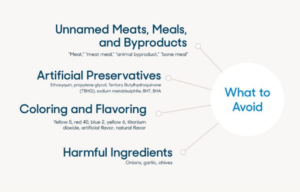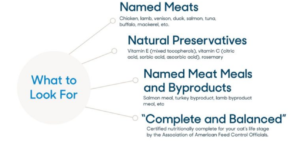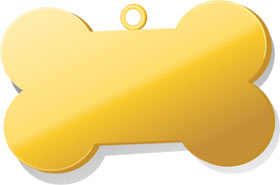After assessing more than 2,000 formulas, we’re happy to recommend 18 of the best cat food brands, both wet and dry.
The best cat food will keep your cat healthy and happy, and will come in a flavor he or she loves. Any high-quality food needs to feature protein front-and-center, and won’t include any low-quality fillers, artificial additives, or ingredients that are toxic to cats over time. To find the most high-quality options available, we scoured the formulas of over 2,400 dry and wet cat foods on the market, read through research and regulations, and talked to veterinarians about what cats need to thrive.
In the end, we identified a shortlist of the best cat food brands and lines that you can count on. Now it’s up to you to figure out what flavors sit well with your cat’s preferences and to find the food that fits your budget. If you’re having trouble deciding between a wet or dry food diet, or you want more information about our top picks, check out our comparison tables and guide to cat food types, below.
The Best Dry Cat Food Brands & Lines
Acana Regionals
Farmina N&D: Ancestral Grain
Farmina N&D: Grain-Free
Holistic Health Extension
Merrick: Before Grain
Orijen
Tiki Cat

The Best Wet Cat Food Brands & Lines
Best Feline Friend: Oh My Gravy
Canada Fresh
Evanger’s: Signature Series
Holistic Health Extension
K9 Feline Natural
Lotus: Just Juicy
Nutrisca: Truly Flaked
Nutrisca: Truly Shredded
Petite Cuisine
Tiki Cat
Wholehearted: Grain-Free Flaked in Gravy
Wholehearted: Grain-Free Flaked in Broth
Ziwi Peak
How We Found the Best Cat Food
We made a list of every cat food we could find: 2,443 formulas.
We started by gathering every non-prescription cat food on the market. Yes, every single formula currently being manufactured, from every single brand in the US. We had one stipulation: We only included foods with “complete and balanced” certification from the Association of American Feed Control Officials (AAFCO), which means each formula has the nutrient profile to function as a cat’s sole nutrition source. (By contrast, nutritional extras like cat treats are tasty, but the feline equivalent of junk food.)
We also opted not to cover raw diets in this review. While we’ve looked at dog food meal delivery services, which offer limited raw options, no such service exists for cats — and raw diets are a contentious subject even among experts. Some of the vets we spoke with loved them, but many strongly advised against them. At stake are concerns over the health hazards posed by raw, room-temperature meat. We’re as interested as anyone in following this space as it develops, but for now, there’s no clear way to judge raw food quality.
When all our gathering was said and done, we had a list of 2,443 wet and dry foods.
We cut low-quality mystery meats and “animal” products with no clear origin.
Because cats are obligate carnivores, their food needs to be meat-based. Four categories of meat ingredients typically show up in cat foods, according to AAFCO:
Meat: The muscle tissue of an animal, like the chicken or steak that humans eat.
Byproducts: The internal parts of an animal that aren’t meat — think organs and bones.
Meat meal: Muscle tissues that have been “rendered” (heat-treated) to destroy bad bacteria and separate out solids from moisture and fat. This leaves a dry “meat concentrate” that’s more nutritionally dense than meat alone.
Byproduct meal: Byproducts that have gone through the same type of rendering process used for meat meal.
While byproducts and meat meal might sound gross, all four options are great protein sources for cats — so long as you know where the protein is coming from. The best cat food companies will tell you from exactly which animal(s) their meat ingredients are sourced, whether “chicken”, “chicken meal”, or “chicken by-products”.
But unspecified protein sources can show up, too. We encountered “meat”, “meat meal”, “animal byproduct”, “animal byproduct meal”, “meat and bone meal” and even “bone product” among our 2,443 contenders.
The FDA specifies that “meat” and “meat byproduct” may be sourced from cattle, pigs, sheep, and/or goats. There’s nothing inherently bad about this, but it’s a roadblock if your cat is a picky eater or has allergies, since you essentially won’t know where your cat food is coming from.
The biggest wildcard is “meal.” Whether “meat meal,” “bone meal,” or “byproduct meal”, the FDA allows sourcing from “mammals other than cattle, pigs, sheep or goats without further description.”
A little digging turns up articles suggesting roadkill and expired groceries make their way into pet food. A statement from the EPA says some meat rendering plants obtain animal byproducts from animal shelters. The FDA found no trace of dog or cat DNA in pet food in a 2000 test — but a 2018 dog food recall for kibble containing trace amounts of the euthanasia drug pentobarbital isn’t reassuring.
The best cat food should leave you confident that you know exactly what you’re feeding your pet. We cut any formula that included unspecified meat, meat byproduct, or meat meal on its ingredients list (including “broth,” “animal fat,” and “liver”).
What we cut: 779
And nixed any ingredients that could do harm over time.
Everything in a cat food formula must be “Generally Recognized As Safe” (GRAS) by the FDA, but that’s a pretty low bar. “Safe” doesn’t necessarily mean “ideal for your cat’s health.” After speaking with experts, we combed through our list of contenders and cut any with colors, flavorings, or ingredients toxic at high doses.
Artificial preservatives
All cat foods contain preservatives — that’s why unopened packages can last for months without spoiling. Some get their staying power through natural ingredients like tocopherols (vitamin E), citric/ascorbic acid (vitamin C), rosemary, sage, and clove. These ingredients are great! We loved seeing them on ingredient lists.
Others use synthetic preservatives like BHA, BHT, TBHQ, and ethoxyquin, which aren’t as cat-friendly. The Center for Science in the Public Interest recommends always avoiding BHA (which the U.S. Department of Health and Human Services lists as “reasonably anticipated to be a carcinogen”) and TBHQ, and to avoid BHT whenever possible. These recommendations are for humans — but the recommendations are based on animal studies. BHA, BHT, TBHQ, and ethoxyquin have all, at some point, proven harmful to animals. Since there are so many natural alternatives, this seemed like a needless risk.
What we cut: 10
Added colors and flavorings
Artificial colors and flavorings are similarly unnecessary and carry some risk for your pet. Not only is it unclear what’s in that artificial flavoring (thanks to very vague guidelines), our experts warned that artificial flavor is often added to compensate for a lack of quality ingredients and can lead to allergic reactions in pets. And artificial colors have been linked to issues like hyperactivity, allergic reactions, and behavior issues in humans, and carry zero nutritional value for your cat.
“Obesity is a serious problem for many indoor cats. Chemical flavor enhancement that encourages them to eat more food than they need isn’t necessary or beneficial. Since most cats readily eat food containing high quality ingredients, that’s a better way to go.”
Roberta Gleicher Certified Pet Advisor
The same holds true for “natural” flavoring. AAFCO guidelines give a loose definition of what makes something “natural” that even they admit “is a liberal term that includes more ingredients than it excludes.”
“‘Natural Flavor’ can have just as much processing as an artificial flavor; if extra flavor has to be added, there is a good chance the protein ingredients weren’t of very high quality to begin with.”
Dr. Robert TrimbleHead of Veterinary Services at Fuzzy Pet Health
We eliminated foods with artificial colors, artificial flavoring, and natural flavoring from our list.
What we cut: 950
Garlic
Some companies hire human taste-testers.These professionals taste food (don’t worry — they’re not required to swallow) and give feedback on how a formula might be altered to taste better.
We were surprised to discover that several formulas used garlic as a flavoring. It’s part of the Allium species (which also includes chives, leeks, scallions, and shallots); over time, steady intake of any plants in this species can damage red blood cells and cause anemia in both cats and dogs. (And one vet notes that “Cats are more susceptible to garlic-induced anemia than are dogs.”) We opted to skip formulas containing garlic anywhere on the ingredient list.
What we cut: 11
Other things you shouldn’t feed your cat:
These ingredients don’t show up in cat food, but if your pet is prone to begging for table scraps, avoid the following:
Anything containing caffeine
Chocolate
Grapes
Raisins
Macadamia nuts
Raw yeast dough
We also expected the first two ingredients to be meat-based.
There’s no way to tell exactly how much of any given ingredient is in your cat food, but you can get a rough idea: Manufacturers are required to list ingredients in order of weight, which means the most prominent ingredients show up first on the list. The Cornell University College of Veterinary Medicine recommends looking for cat foods for which “meat, meat byproducts, or seafood are listed among the first few ingredients, as this indicates the food probably contains enough animal-source ingredients to supply essential amino acids and fatty acids.” So we looked for food with animal-based ingredients in at least the first two spots.
“It does not need to be 100 percent meat, but it should be majority meat-based and without question, the protein sources should be meat-based. Thus, any plant-based ingredients should come after the meat.”
Dr. Gary RichterMedical Director, Montclair Veterinary Hospital and Holistic Veterinary Care
We said goodbye to formulas like Country Value, which lists “whole grain corn” as its first ingredient, and several Farmina formulas that led with corn gluten and ground rice. We also ditched Ami Cat and Benevo, which bill themselves as “vegan” cat foods and don’t have any meat-based ingredients at all.
For canned food, which typically features fewer plant-based ingredients, we skipped formulas in which “water sufficient for processing” was a star ingredient. (Water won’t hurt your cat, but we’d rather see less water and more meat.)
What we cut: 238
Updated-Cat-Food-ingredients-for-Cat-Food
Finally, we focused on brands and lines without any subpar formulas.
The overall quality of our 70 remaining brands was extremely uneven. A handful, like Orijen and Tiki Cat, led the pack: Every single one of their formulas and flavors hit our benchmarks. You want to try Tiki Cat’s Luau Chicken With Egg instead of their Velvet Mousse Chicken & Wild Salmon? Go ahead: all their 34 cat foods are great.
Then there were options like Nutrisource — out of the brand’s 19 flavors only two survived. To avoid the effort of trying to remember that the “Chicken and Rice” formula is okay but the “Chicken, Turkey & Lamb” formula is not (it’s got artificial flavoring), we made an additional cut. Our finalists for best cat food had to fall into one of two camps:
Brands that passed our cuts across the board. We had eight all-star options — companies whose every formula met our requirements, and which we applaud for adhering to high standards:
Acana Regionals
Canada Fresh
Holistic Health Extension
K9 Feline Natural
Orijen
Petite Cuisine
Tiki Cat
Ziwi Peak
Brands with full lines that passed. Lotus’s Oven-Baked line got cut for including garlic, but the seven flavors in their Just Juicy line are all great. This second category requires a little more effort to keep track of, but gives you additional flavors and price points to choose from.





Thank you, everyone! ?custom writing
Emery Fitzgerald, thanks for the article post.Really thank you! Great.cialis
Emery Fitzgerald, thanks a lot for the article post.Much thanks again. Fantastic.
Great job!!! Same thing needs to be done for dog food. Lots of “junk” food out there and all it does is shorten an animals already short life.
Nice Blog Here is some information about cats.
My Own Cats